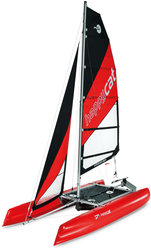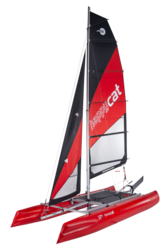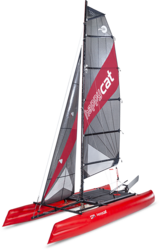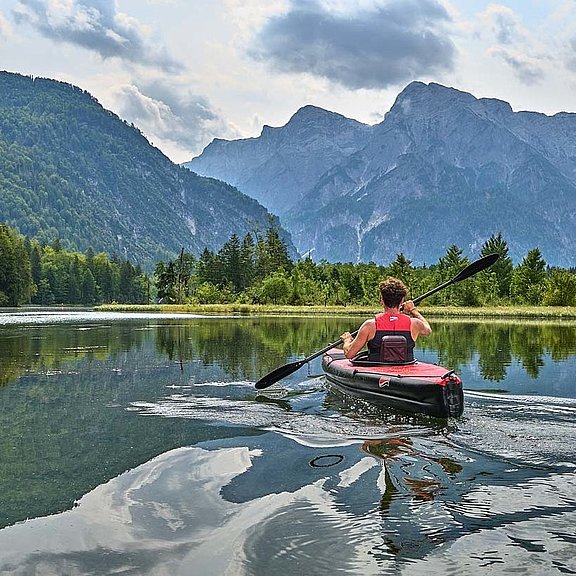
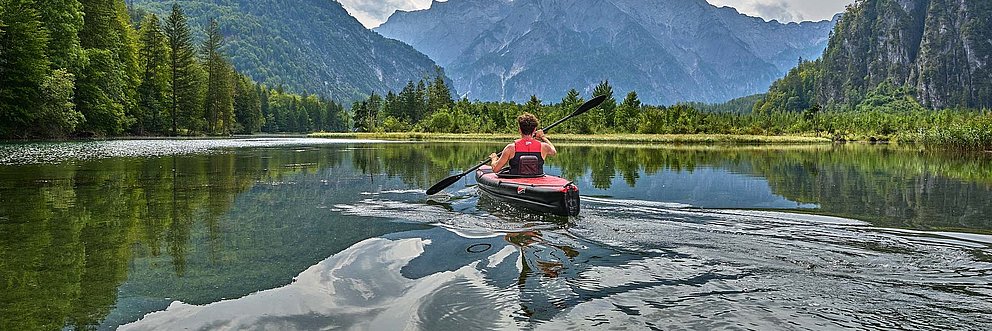

Frequently asked questions
Boat material + quality
-
What are the handling characteristics of an inflatable boat compared to a rigid boat?
Compared to a rigid boat, an inflatable boat has a slightly larger water wetting surface and therefore a slightly higher paddling effort.
When it comes down to "seconds", a rigid boat is superior. However, when it comes to safety, tipping stability or travel comfort, the advantages of inflatable boats outweigh the disadvantages.
-
How resistant is the boat material to gravel, rocks, sharp stones and metal objects?
An inflatable boat yields elastically when it hits an obstacle so that no hole is created. Stones in the water are usually smooth and slippery and the boat slides over them without damage.
Only very sharp metal objects or sharp corals could damage the material. The boat should also not be dragged across the bottom.
-
Are inflatable boats seawater-safe?
Yes - of course!
Subsequent cleaning with fresh water and leaving in a care product is recommended and increases the service life. -
What references can you quote me on durability?
Most convincing is the fact, that more and more boats come to be serviced by us, boats that are 20 years and even older, and apart from possible traces of wear they are still in good order. Durability very much depends on the extent of treatment and regular care.
If you adhere to the recommendations of the operating manual, you will enjoy your GRABNER boat for many years to come.
-
What is the life expectancy of a GRABNER inflatable boat?
Under normal use, correct care and storage, approximately 20 – 25 years.
-
How do inflatable boats cope in windy conditions?
By nature of high buoyancy inflatable boats have very little draught, and for that reason slightly more susceptible to the wind compared to solid hull boats.
Wind susceptibility can be reduced by optimising the boats weight distribution pattern or additional ballast.
For Kayaks the use of steering-rudder is recommended. -
What happens when a inflatable boat is exposed to the sun?
When the boat is stored exposed to the sun outside water for a longer while, it should be moved to a place in the shade or covered up.
Best reduce air pressure to min. 0.2 bar.
Direct exposure to sunlight over a longer period is detrimental to the boat material – Rubber dries out and becomes porous. To prevent that, do not leave the boat unnecessarily exposed to direct sun. Apart from that regularly treatment of the boat by applying boat care agent to prevent the boat-skin to dry out, will keep it supple.
-
How do the boats air-valves function?
The valves are designed with lock knob valve plate. - Pressing plus quarter turn = valve is open - Pressing and quarter turn = valve is closed. Before renewed inflation the valve must be set at closed, otherwise the air will stream out during the inflation process.
-
What material are GRABNER boats made of?
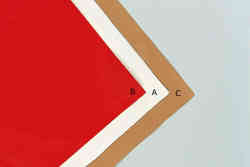
The 3-layer boat-skin consist of:
A: High-strength backing fabric – the rating of which and weight ratio distinctly outweighs that of steel.
B: The boat-skin exterior sheathing is EPDM. EPDM = mix compound of precious polymers (caoutchouc) – age resistant, ozone-resistant, seawater consistent, colour proof
C: At the inner surface a mix compound lining of butyl natural caoutchouc provides sufficient airtightness and flexibility.
-
What is the difference between a GRABNER boat and PVC?
If stored and maintained correctly, rubber boats are still in good condition after 20 -25 years.
P’VC boats gradually loose the internal plasticiser (softener), which renders the material brittle and prone to tear.
Rubber boats remain smooth, and pliable, even at low temperatures, whereas PVC -boats become stiff to the extent that they can hardly be folded small together.Rubber boats when damaged, can be repaired easy. (same principle as repairing a bicycle tube).
PVC -boat repair mostly requires special repair- shop attendance, especially when major damage needs to be repaired.In contrast to PVC boats, rubber boat production and disposal poses no environmental problems.
-
What is the difference between a GRABNER boat and a boat with outer sewn textile covering of an inner PVC-tube?
A major difference!
The outer sewn textile covering may look attractive, but deteriorates rather fast. Stitching becomes undone, fittings become detached. The inner tube accepts low operating air pressure inflation only. As such there is no comparative similarity at all to the absolute abrasion resistant, longevity and high operating air-pressure of GRABNER boats.
-
What is the meaning of "Hot-vulcanisation"?
In order that raw-caoutchouc becomes a finished rubber product, it has to undergo a process of vulcanisation.
Caoutchouc (general term for elastic polymers) is harvested from the caoutchouc-tree (Hevea Brasiliensis). Tapping into the latex-tree supplies a white milk like sap, which when further processed becomes raw-caoutchouc. By way of vulcanisation i.e. high pressure hot steam process of an autoclave apparatus it becomes finished rubber.
Rubber is a renewable resource product, offering unbeatable advantages over PVC and other materials. Best examples are car tyres, which for reasons of high requirement specification are exclusively made from rubber.
GRABNER inflatable boats are manufactured under “HOT-VULCANISATION” process technology. The raw-caoutchouc sections (without subjecting to roughening) are bonded together, and only the semi-finished boat will then undergo pressure and heat vulcanisation. That technology ensures that the bonding melts to form one homogeneous unit with optimised air-tight and cohesive properties.
There is no better way of manufacturing a quality inflatable boat. -
What is the operating air-pressure and what kind of pump is needed?
The operating air-pressure of all GRABNER boats is 0.3 bar(4.3 psi).
The safety bulkheads of the Raft have an operating air-pressure of 0.02 bar (0.3 psi)That pressure can be obtained i.e. using a high pressure bellow pump, dual stroke pump, or electric pump of 12 V.
Most electric pumps do not quit reach the operating pressure, the remaining pressure are best to applied by manual pump.Electric pumps for car tyres are not suitable for the use with inflatable boats. Although they generate high pressure, they produce to little volume, which would take too long to inflate the boat.
Under no circumstance should the boat be inflated by compressor. Likely oil residues in the air could damage the interior rubber lining. -
How can I avoid excess air-pressure with my GRABNER boat?
If on a cool morning the operating air-pressure applied by pumping indicates 0.3 bar, that pressure, under the influence of exposure to direct sun and respective heat, will increase up to 0.6 bar.
The boat will stand up to that overpressure for a short while, but for the sake of durability that pressure should be reduced to 0.3 bar.Check the air-pressure by means of the Pressure relief adapter and if need be release some of the air.
-
How important are operating instructions?
Questions often submitted in writing or by telephone, are available in detail as part of the operating manual, which come with every boat, and which can be accessed =>> online for download.
Before taking the trouble of submitting a special enquiry, best first check and read the operating instructions of your boat. 99 % of your likely questions you will find are answered with.
What you find is not covered within the operating manual, you may find an answer to among the FAQs. If all of that does not answer your question, we are pleased to check with you for an individual answer.












